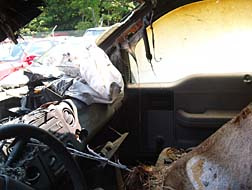Kane also has some definite opinions about the long saga of the recall of Ford vehicles equipped with the Texas Instruments cruise control deactivation system (CCDS). To him, it's a classic example of how big automotive companies work to limit their liability for product defects in the face of evidence and regulatory pressure.
The root of the defect, Kane says lies in the fact that "Ford kept the CCDS always powered on—even when the vehicle was turned off—against the manufacturer's advice." The always-on CCDS has been identified as the cause of engine fires in Ford vehicles and of the ongoing 10.5-million vehicle recall.
 From the beginning ten years ago, Kane says, "Ford knew they had a problem with always-on, but they made the recall happen as slowly and narrowly as possible. Someone at Ford did a cost-risk analysis for different vehicles and they limited their recall to those that showed the greatest frequency of engine fires.
From the beginning ten years ago, Kane says, "Ford knew they had a problem with always-on, but they made the recall happen as slowly and narrowly as possible. Someone at Ford did a cost-risk analysis for different vehicles and they limited their recall to those that showed the greatest frequency of engine fires."This is a remarkable parallel to other recalls. It's the 'defendable fence' approach. Ford sent out a document that tried to limit the recall to specific vehicles and corral in their costs and liability. If you look at the history, one thing becomes clear—Ford knew they had a problem many years ago; they should have taken responsibility for it, but instead they decided to wait out the risk and built the fence."
Kane credits the National Highway Transportation Safety Board with pushing back Ford's defendable fence: "The reality is that NHTSA's defect office has only 20 people to cover the entire automotive industry, so their resources are limited, especially compared with a company like Ford. That they stuck with it and kept the pressure on over the years is a success story. It maybe took longer than it should have, but overall they did a great job—and that's coming from someone who's a frequent critic of NHTSA.
"It's troubling, though, that it took so much time and so much research. Ford should have taken responsibility voluntarily, because the responsibility lies with them for allowing the always-on switch for so many years."
READ MORE LEGAL NEWS
Kane is uncertain about the scale or causes of the persistent reported shortages of CCDS replacement parts. He suggests that it may be partially rooted in reluctance of dealership service departments to take on recall work, which takes time and pays less than normal repairs. He also wonders about Ford's "attrition model", their way of estimating the numbers of affected vehicles that are still on the road."Ford's model may or may not be accurate," he says. "There's production data, of course, and you can estimate vehicle numbers based on that. But there's also registration data, which can give you actual numbers of vehicles registered and in use. That information is readily available, and if they didn't research that data, it's inexcusable."
"The good news in all of this, if there is any, is that the damage from engine fires has been mostly limited to property damage—which isn't much consolation to the consumer who's affected."
By Paul Halpe




